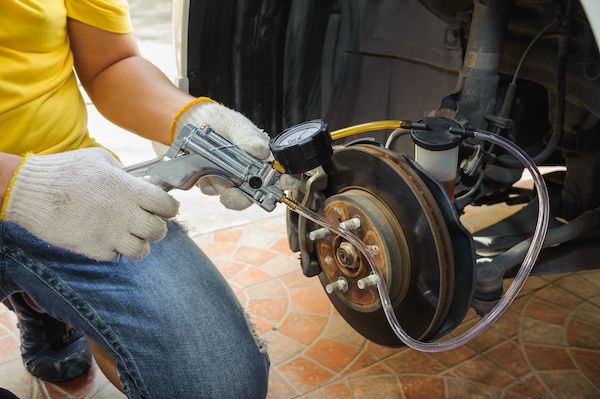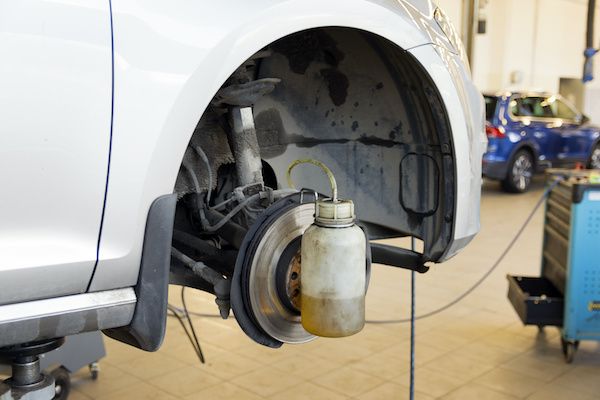


Brake lines are an essential component of a vehicle's braking system, serving as the conduit for transmitting hydraulic pressure from the master cylinder to the brake calipers or wheel cylinders. They play a crucial role in ensuring effective and reliable braking performance. Here are some key points highlighting the importance of brake lines: Hydraulic Pressure Transmission: Brake lines carry the hydraulic pressure generated by the master cylinder when the brake pedal is depressed. This pressure is transmitted through the lines to the brake calipers or wheel cylinders, which then apply the brakes to slow down or stop the vehicle. Braking Force Distribution: The network of brake lines ensures that the braking force is evenly distributed to all four wheels, providing balanced and controlled braking. Proper brake line routing and design are essential for maintaining this even distribution. Safety and Control: Well-maintained and properly functioning brake lines are critical for vehicle safety and control. Any leaks, blockages, or damage to the brake lines can compromise the braking system's effectiveness, potentially leading to accidents or loss of control. Durability and Reliability: Brake lines are designed to withstand high pressures, vibrations, and exposure to various environmental conditions. However, over time, they can become susceptible to wear, corrosion, or damage, which can affect their performance and reliability. Maintenance and Inspection: Regular inspection and maintenance of brake lines are essential to ensure their integrity and proper functioning. Worn, cracked, or damaged brake lines should be replaced promptly to maintain the braking system's efficiency and safety.

Over time, brake fluid can become contaminated and lose its effectiveness due to various reasons. This can lead to a range of problems that can compromise your vehicle's safety and performance. Let's explore some of the most common consequences:
| Issue | Description |
|---|---|
| Reduced Braking Performance | Contaminated or old brake fluid can cause internal corrosion and wear in the brake components, reducing the overall braking efficiency. This can result in longer stopping distances, which can be dangerous, especially in emergency situations. |
| Spongy Brake Pedal | Air trapped in the brake lines can create a spongy or soft brake pedal feel. This can make it difficult for the driver to modulate braking pressure accurately, leading to potential safety hazards. |
| Component Failure | Neglecting brake line flushing can accelerate the wear and tear on critical components like calipers, master cylinders, and brake boosters. This can lead to costly repairs or even complete component failure, compromising your vehicle's safety. |
Throughout my career, I've encountered numerous cases where brake line flushing could have prevented major issues or even accidents. Let me share a few examples:
One of my customers, let's call him John, brought in his sedan complaining about a spongy brake pedal. Upon inspection, I discovered that air had been trapped in the brake lines, likely due to improper bleeding procedures during a previous brake job. We performed a complete brake fluid flush and bleeding process, following these steps:
Inspected the brake lines and components for leaks or damage
Connected a specialized flushing machine to the brake system
Pumped fresh brake fluid through the lines while simultaneously removing the old, contaminated fluid
Bled the brake system to remove any remaining air pockets
After completing the process, the spongy pedal issue was resolved immediately, and John regained confidence in his vehicle's braking capabilities.
Another customer, Sarah, had been experiencing intermittent braking issues with her SUV. When we checked the brake fluid, it was discolored and cloudy, indicating severe contamination. Here's how we addressed the issue:
Visually inspected the brake system for leaks or damage
Performed a complete brake fluid flush, replacing the contaminated fluid with fresh, compatible fluid
Bled the system to remove any remaining air pockets
Inspected and replaced worn brake pads and rotors
After the thorough flush and component replacements, the braking performance was restored, and Sarah could once again rely on her vehicle's braking capabilities without any hesitation.
Preventive maintenance is key to avoiding costly repairs and ensuring your vehicle's safety. Neglecting brake line flushing can lead to a cascade of issues that can quickly escalate in severity and expense. By following the manufacturer's recommended maintenance schedule and having your brake system inspected regularly, you can catch potential problems early and address them before they become major concerns.
Here's a table outlining the recommended maintenance intervals for various brake system components:
| Component | Maintenance Interval |
|---|---|
| Brake Fluid Flush | Every 2-3 years or as recommended by the manufacturer |
| Brake Pad Replacement | Every 25,000 - 50,000 miles, depending on driving conditions |
| Brake Rotor Inspection/Replacement | Every 50,000 - 70,000 miles, or when pads are replaced |
| Brake Line Inspection | During routine maintenance or when issues are detected |
Regular maintenance and addressing issues promptly can help prevent more expensive repairs down the line and ensure the safety and proper functioning of your vehicle's braking system.

For those interested in the technical details, here's a step-by-step overview of the brake line flushing process:
Inspection
Visually inspect the brake lines, components, and fluid condition to identify any potential issues or leaks.
Check for warning lights on the dashboard or unusual noises during braking.
Fluid Replacement
Connect a specialized flushing machine to the brake system, which allows us to pump fresh brake fluid through the lines while simultaneously removing the old, contaminated fluid.
Follow the manufacturer's recommended procedure for fluid replacement and bleeding.
Bleeding
After the fluid replacement, we bleed the brake system to remove any remaining air pockets.
This process involves opening the bleeder valves at each caliper or wheel cylinder and pumping the brake pedal to force the air out of the lines.
Start with the caliper furthest from the master cylinder and work towards it.
Final Checks
Once the flushing and bleeding are complete, we perform a final inspection and test the brake pedal firmness and overall braking performance.
Ensure that the brake pedal feels firm and responsive, and that the vehicle stops smoothly and consistently.
The cost of a brake line flush can vary depending on your vehicle's make and model, as well as the labor rates in your area. On average, you can expect to pay within the following ranges:
| Service | Cost Range |
|---|---|
| Brake Fluid Flush | $80 - $150 |
| Brake Line Replacement | $150 - $400 (per line) |
| Caliper Replacement | $200 - $500 (per caliper) |
| Master Cylinder Replacement | $300 - $800 |
| Brake Booster Replacement | $400 - $1,000 |
Note that these costs can vary based on factors like your vehicle's make and model, labor rates in your area, and any additional repairs needed. It's always recommended to get a quote from a reputable mechanic or dealership for an accurate estimate.
While the cost of a brake line flush may seem like an additional expense, it's a small price to pay for the peace of mind and safety that comes with a properly functioning braking system.
As a mechanic, I cannot stress enough the importance of regular brake line flushing. Neglecting this crucial maintenance task can lead to a range of issues, from reduced braking performance to component failure and potential safety hazards. By staying proactive and addressing brake line flushing as part of your regular maintenance routine, you can ensure your vehicle's braking system remains in top condition, providing you with the confidence and control you need on the road.
Remember, your safety and the safety of those around you should be the top priority. Don't wait until it's too late – schedule a brake line flush today and experience the peace of mind that comes with a well-maintained braking system.
Some signs that indicate your brake fluid needs flushing include a spongy or soft brake pedal feel, dark or discolored brake fluid, and warning lights on the dashboard related to the braking system.
During the brake fluid flush process, the mechanic will inspect the brake lines for any leaks, damage or excessive corrosion. If issues are found, they may recommend replacing the affected brake lines.
While it is possible to flush brake fluid yourself if you have mechanical experience, it is generally recommended to have a professional mechanic perform this service to ensure it is done correctly and safely.
The time required for a complete brake fluid flush can vary, but typically takes around 1-2 hours for a professional mechanic to perform the service properly.
Neglecting to replace your brake fluid regularly can lead to moisture contamination, reduced braking performance, internal corrosion of brake components, and potentially costly repairs or replacements.
Yes, there are different types of brake fluid (DOT 3, DOT 4, DOT 5.1, etc.) with varying boiling points and characteristics. It's crucial to use the type specified by your vehicle's manufacturer.
Old brake fluid should be disposed of at a hazardous waste disposal facility or an authorized collection site, as it can be harmful to the environment if not handled correctly.
No, you should never mix different types of brake fluid as it can cause contamination and potentially damage the brake system components. Always use the type specified by the manufacturer.
It's recommended to have your brake pads and rotors inspected during routine maintenance or whenever you notice any issues with braking performance, such as squeaking, grinding, or pulsation.
Yes, neglecting regular brake maintenance, including fluid flushes, can lead to reduced braking performance, component failure, and potentially increase the risk of accidents or collisions due to compromised braking capabilities.

Sarah isn't your average gearhead. With a double major in Mechanical Engineering and Automotive Technology, she dived straight into the world of car repair. After 15 years of turning wrenches at dealerships and independent shops, Sarah joined MICDOT to share her expertise and passion for making cars run like new. Her in-depth knowledge and knack for explaining complex issues in simple terms make her a valuable asset to our team.



